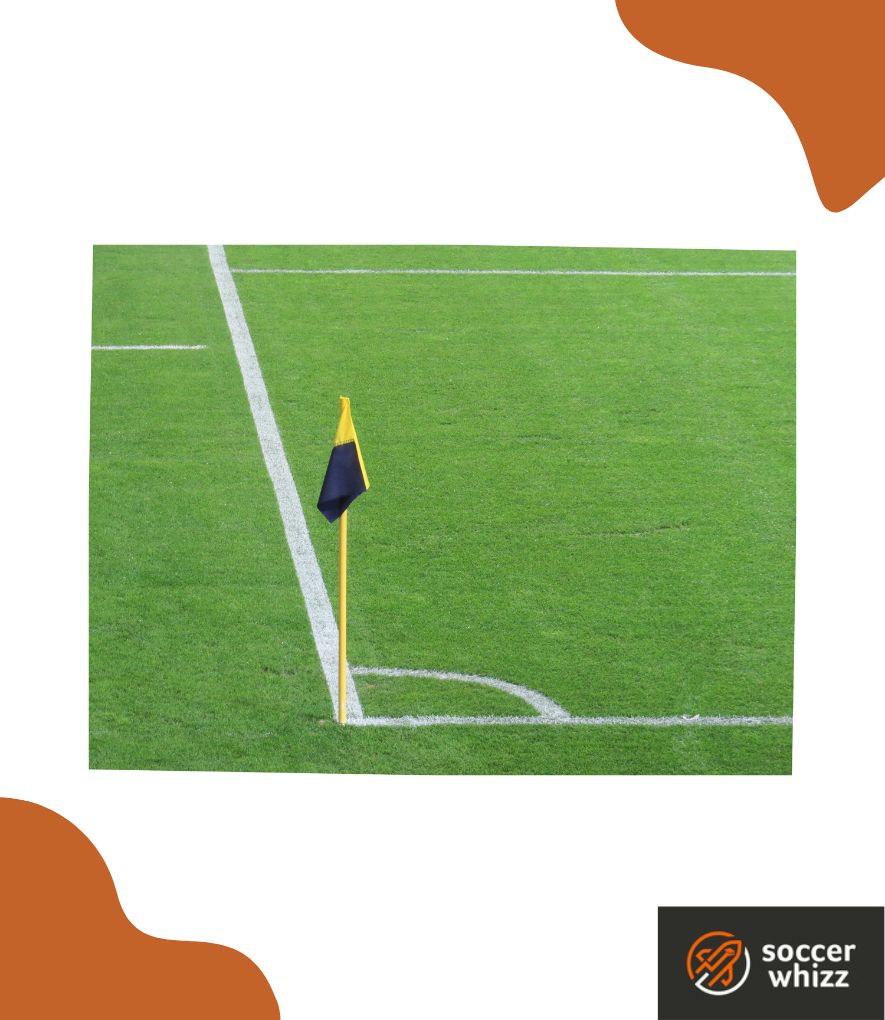Corner kicks possess an inherent air of unpredictability, allowing for moments of both triumph and despair.
A corner kick occurs when the ball crosses the goal line, having been last touched by a defending player, resulting in an attacking team earning a valuable set-piece opportunity.

With the power to change the course of a match, the corner kick has become an indispensable weapon in the arsenal of any team aspiring to conquer the beautiful game.
This article aims to unravel the multifaceted nature of the corner kick, exploring its origins, tactics, and the significant impact it has had on the evolution of soccer.
We’ll cast a keen eye into the tactical considerations that underpin a successful corner kick routine, dissecting the roles of players on both the attacking and defending sides.
- When is a corner kick awarded in soccer?
- What are soccer's main corner kick rules?
- Which player position usually takes corner kicks during games?
- How many corners does a typical soccer game often have?
- Can you legally score a goal from a corner kick?
- Is it possible to be offside from a corner kick in soccer?
- What is the difference between a goal kick and a corner kick?
- Concluding thoughts
When is a corner kick awarded in soccer?
In soccer, a corner kick is granted when the entire ball crosses the goal line, either on the ground or in the air, after being touched last by a defending player, resulting in a goal not being scored.
What are soccer’s main corner kick rules?
Key guidelines for a corner kick include:
1. Positioning
The ball should be placed in the corner area that is closest to where it crossed the goal line.
2. Stationary ball
Prior to the kick, the ball must be at a standstill and not in motion.
Like so:

It is then kicked by a player from the attacking team.
3. In play moment
As soon as the ball is kicked and begins to move, it is considered in play.
It is important to note that the ball does not necessarily need to leave the corner area to be in play.
4. Fixed corner flag post
The corner flag post must not be disturbed or moved during the corner kick.

5. Opponent distance
Until the ball is officially in play, opponents are required to maintain a minimum distance of 9.15 meters (10 yards) from the corner arc.
Which player position usually takes corner kicks during games?
The player position commonly responsible for taking corner kicks during games is typically a midfielder or a forward.
These players possess the technical skills required to deliver accurate and well-placed crosses into the penalty area.
More so, their ability to control the trajectory and speed of the ball, coupled with their understanding of the team’s tactics and set-piece routines, makes them ideal candidates for executing corner kicks effectively.
However, depending on the team’s strategy and the specific strengths of the players, corner kicks can also be taken by other positions on the field.
How many corners does a typical soccer game often have?
Recent data suggests a slight decrease in the number of corners per game compared to the period between 1997 and 2005.
Most notably, only one club, Everton, has maintained an average of 11 corners or more in their first 14/15 games of the season, reaching an impressive 12.27.
Newcastle United follows at a distant second with 10.96 corners, while Crystal Palace records the lowest number at 8.50 (including the average corners won by both Palace and their opponents).
Most importantly however, is the fact that:
“Half of all Premier League matches (since 1997) finish with between nine and 13 corners, and two-thirds finish with between eight and 14.”
Source
When considering the league average for the current season, it stands at 10.18 corners per game.
Similar figures were observed in the previous league campaign of 2021/22, with an average of 10.15 corners per match.
In the 2019/20 season, the number slightly increased to 10.70 corners, with home teams generally earning more corners than away teams.
Ultimately, these statistics provide insight into the fluctuating trends of corner kicks in recent years, highlighting the varying levels of attacking opportunities and strategic approaches employed by different teams in the English Premier League.
Can you legally score a goal from a corner kick?
A corner kick holds the potential for a goal to be directly scored, but it can only count against the opposing team.
If the ball happens to directly enter the goal of the player taking the corner kick, a corner kick is then awarded to the opponents.
Here are a few examples of players that have scored directly from corner kicks:
Toni Kroos
Seizing the opportunity presented by Valencia goalkeeper Jaume’s continued engagement in a heated debate with the referee after the corner was awarded, Kroos took charge of the situation and dictated the game’s tempo.
Observing the shot-stopper positioned far away from his goal-line, the German midfielder calmly executed a skillful curling shot towards the near post, encountering minimal resistance.
However, the stunned roars of the crowd greeted his audacious strike.
Here’s video footage of that particular moment:
Thierry Henry
In 2012, during a match against Columbus Crew, the French winger delivered a goal from a corner kick that epitomized pure nonchalance.
With impeccable finesse, the former Arsenal player elegantly bent the ball towards the far post.
The audacious strike reverberated off the woodwork before finding the back of the net with remarkable flair, leaving the goalkeeper quite taken aback, sporting a rather flushed expression on his face.
Let’s relive this moment by taking a momentary trip to the past:
Is it possible to be offside from a corner kick in soccer?
In the realm of soccer, a player is exempt from being offside if they receive the ball directly from a corner kick.
Nevertheless, once a second player has made contact with the ball, the offside rule is reintroduced by the referee.
This unique aspect of the game grants any attacking player the freedom to position themselves in close proximity to the goal as they desire.
Consequently, it is a common sight to witness the defending team stationing themselves right on the goal line, steadfastly safeguarding their goal from imminent threats.
What is the difference between a goal kick and a corner kick?
A corner kick occurs when the ball is positioned in the corner of the soccer field, specifically at the end closest to the goal being targeted by the attacking team in their quest to score.
On the other hand, a goal kick is executed from the 6-yard box adjacent to the defending team’s goal.
A goal kick is granted when the ball crosses the goal line at the end of the field, with the last player to have made contact belonging to the team attacking the goal.
In cases where no goal has been scored, the defending team has the opportunity to take a goal kick from any location within their own 6-yard box.
The significant distinction between a corner kick and a goal kick lies in the ball crossing the goal line at the end of the field, with the last player to have touched it being a member of the defending team.
At this juncture, the attacking team is granted the chance to execute a corner kick.
For more information on what a goal kick is, have a read of the hyperlinked article.
Concluding thoughts
As the game continues to evolve, so too do the approaches to corner kicks.
New tactics and variations emerge, challenging defenders and goalkeepers to adapt to ever-changing circumstances.
Coaches meticulously analyze opponents, seeking the slightest vulnerabilities to exploit from corner kicks, making this set-piece a battleground of strategic wits.
Before you go, you might want to have a look through our posts that break down similar soccer concepts, such as:
- what a kick off in soccer represents;
- what a soccer free kick is; and
- what a bicycle kick in soccer means
If you enjoy the content that I create and would like to buy me a coffee, then I’d really appreciate it!
Any money that I earn through this donation will be re-invested into more content for this website.
Additionally, by sending in a donation you’ll also receive a copy of my recently released 190+ page eBook on Soccer Ball Care, as well as be subscribed to our mailing list where you’ll be regularly informed on the latest developments concerning the Soccer Whizz blog.
- Future Icons: Europe’s Emerging Midfield Maestros Set for Glory - December 4, 2023
- Kickstarting a Revolution: How Soccer Transformed the United States Over the Last Four Years - October 7, 2023
- 4-1-4-1 Soccer Formation [Analysis] - September 23, 2023

